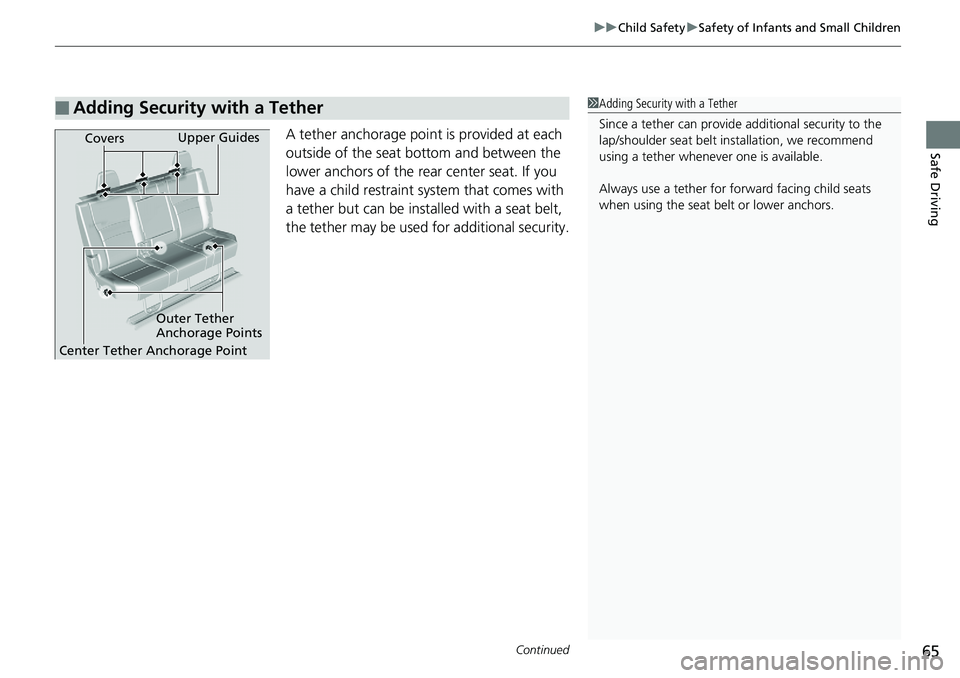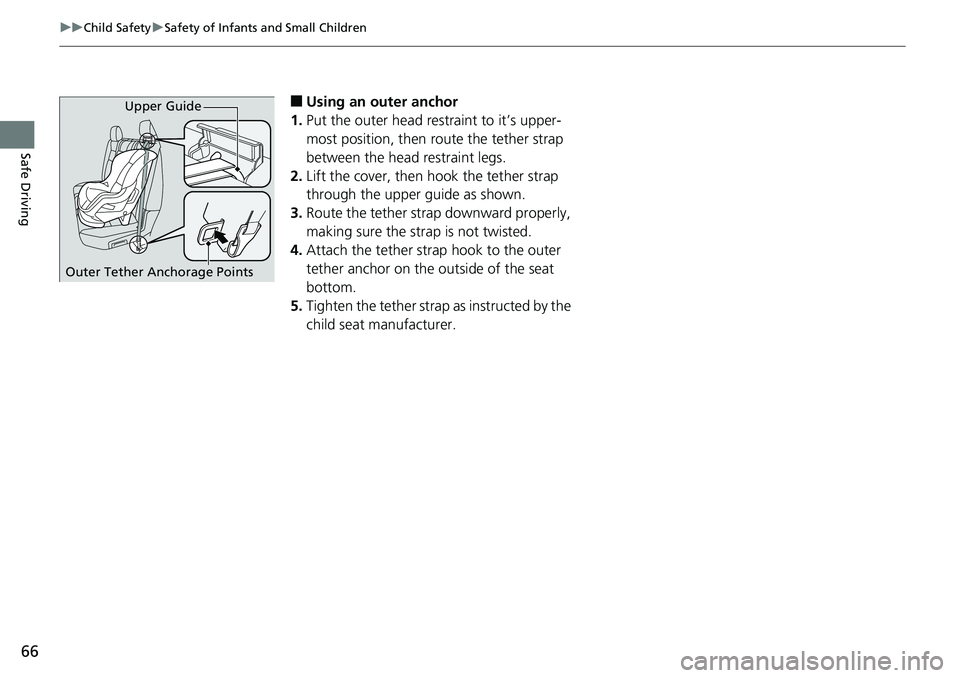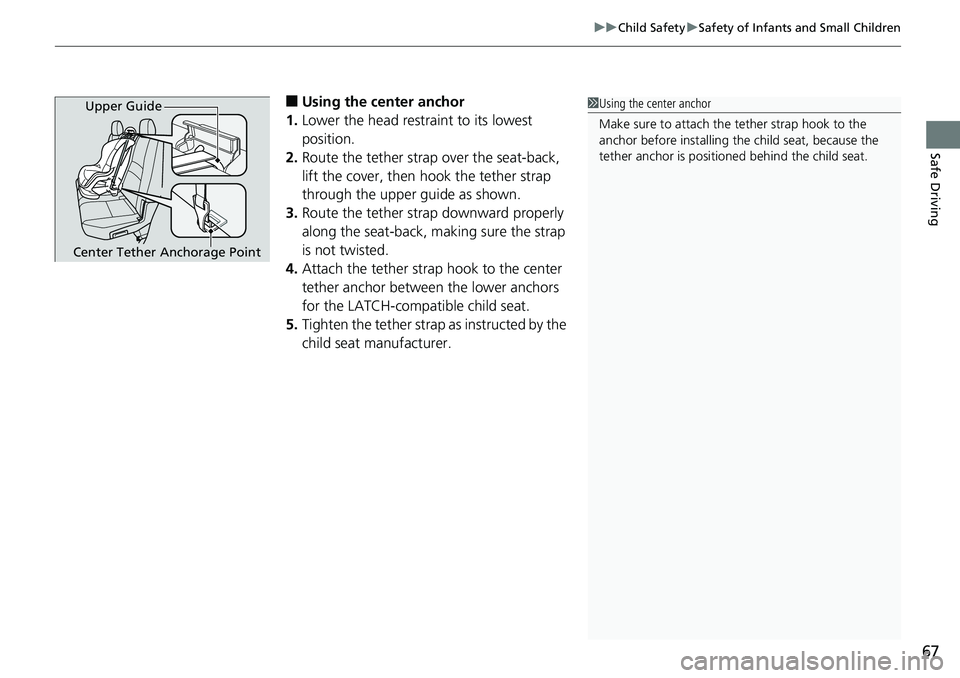2018 HONDA RIDGELINE child restraint
[x] Cancel search: child restraintPage 12 of 623

10
Quick Reference Guide
Safe Driving (P29)
Airbags (P42)
● Your vehicle is fitted with airbags to help protect you and
your passengers during a moderate-to-severe collision.
Child Safety (P55)
● All children 12 and younger should be seated in the rear seat.
● Smaller children should be properly restra ined in a forward-facing child seat.
● Infants must be properly restraine d in a rear-facing child seat.
Exhaust Gas Hazard (P70)
● Your vehicle emits dangerous exhaust gases that contain carbon
monoxide. Do not run the engine in confined spaces where carbon
monoxide gas can accumulate.
Before Driving Checklist (P34)
● Before driving, check that the front seats, head restraints,
steering wheel, and mirrors have been properly adjusted.
Seat Belts (P35)
● Fasten your seat belt and sit upright well
back in the seat.
● Check that your passengers are wearing
their seat belts correctly.
Fasten your lap belt as
low as possible.
Page 36 of 623

34
uuFor Safe Driving uSafety Checklist
Safe Driving
Safety Checklist
For the safety of you and your passenge rs, make a habit of checking these items
each time before you drive.
• After everyone has entered the vehicle, be sure all doors are closed and locked.
Locking the doors helps prevent an occupant from being ejected and an outsider
from unexpectedly opening a door.
2 Locking/Unlocking the Doors from the Inside P. 121
•Adjust your seat to a position suitable for driving. Be sure the front seats are
adjusted as far to the rear as possible while allowing the driver to control the
vehicle. Sitting too close to a front airbag can result in serious or fatal injury in a
crash.
2 Adjusting the Seats P. 163
•Adjust head restraints to the proper posi tion. Head restraints are most effective
when the center of the head restraint alig ns with the center of your head. Taller
persons should adjust their head restraint to the highest position.
2 Adjusting the front head restraint positions P. 168
•Always wear your seat belt, and make sure you wear it properly. Confirm that any
passengers are properly belted as well.
2 Fastening a Seat Belt P. 38
•Protect children by using seat belts or chil d seats according to a child’s age, height
and weight.
2 Child Safety P. 55
1Safety Checklist
If the door, trunk and/or tailgate open message
appears on the multi-inform ation display, the door,
the trunk and/or the tailgate is not completely closed.
Close all doors, the trunk and the tailgate tightly until
the message disappears.
Page 45 of 623

43
uuAirbags uAirbag System Components
Continued
Safe Driving
The front, front side, and side curtain
airbags are deployed according to the
direction and severity of impact. Both side
curtain airbags are deployed in a rollover.
The airbag system includes:
aTwo SRS (Supplemental Restraint System)
front airbags. The driver’s airbag is stored
in the center of the steering wheel; the
front passenger’s airbag is stored in the
dashboard. Both are marked SRS
AIRBAG.
bTwo side airbags, one for the driver and
one for a front passenger. The airbags are
stored in the outer edges of the seat-
backs. Both are marked SIDE AIRBAG.
cTwo side curtain ai rbags, one for each
side of the vehicle. The airbags are stored
in the ceiling, abov e the side windows.
The front and rear pillars are marked
SIDE CURTAIN AIRBAG.
dAn electronic control unit that, when the
vehicle is on, continually monitors
information about the various impact
sensors, seat and buc kle sensors, airbag
activators, and seat belt tensioners.
During a crash event the unit records
such information.
eAutomatic front seat belt tensioners. In
addition, the driver’s and front
passenger’s seat belt buckles incorporate
sensors that detect whether or not the
belts are fastened.
fA driver’s seat position sensor. If the seat
is too far forward, the airbag will inflate
with less force.
gWeight sensors in the front passenger’s
seat. The front passenger’s airbag will be
turned off if the weight on the seat is
approximately 65 lbs (29 kg) or less (the
weight of an infant or small child).
hImpact sensors that can detect a
moderate-to-severe front or side impact.
iAn indicator on the da shboard that alerts
you that the front passenger’s front
airbag has been turned off.
jAn indicator on the instrument panel that
alerts you to a possible problem with your
airbag system or seat belt tensioners.
kSafing Sensor
lA rollover sensor that can detect if your
vehicle is about to ro ll over and signal the
control unit to deploy both side curtain
airbags.
Page 63 of 623

Continued61
uuChild Safety uSafety of Infants and Small Children
Safe Driving
6. Place the child seat on the vehicle seat, then
attach the child seat to the lower anchors
according to the ins tructions that came
with the child seat.
1 Installing a LATCH-Compatible Child Seat
Installing a LATCH-compatible child seat in the
rear center seat
Each outer rear seat is equipped with a pair of lower
anchors which are used to secure a LATCH-compatible
child seat. The rear center seat, however, is not
equipped with anchors of any kind. The inner and
outer anchors are spaced apart at a standard distance
of 11 inches (280 mm). The distance between the two
inner anchors is 21.7 inches (550 mm).
LATCH-compatible restraint systems that are fitted
with rigid-type attachments cannot be installed in the
rear center seat. However, a system fitted with
flexible-type attachments can be installed in the
center seat, provided that the manufacturer’s
instructions for that system permit the use of the
inner anchors with the stated spacing.
Before seating a child, make sure that the system is
properly attached to both the lower anchors and
tether anchors.
3WARNING
Do not use the lower inner anchors of the
outer rear seats to secure a LATCH-
compatible child seat to the rear center
seat, unless the manufacturer’s instructions
for that system permit the use of inner
anchors with the stated spacing.
Flexible Type
Lower Anchors
All positions
Rigid Type
Page 64 of 623

62
uuChild Safety uSafety of Infants and Small Children
Safe Driving
7. Put the outer head restraint to it’s upper-
most position (or remove it), then route
the tether strap over the seat-back and
through the head restraint legs.
8. Lift the upper guide co ver, then route the
tether strap around the upper guide.
9. Route the tether strap downward
properly, then attach the strap hook to the
tether anchor under the seat. See the
label.
u Making sure the strap is not twisted.
10. Tighten the tether strap as instructed by
the child seat manufacturer.
11. Make sure the child seat is firmly secured
by rocking it forward and back and side to
side; little movement should be felt.
12. Make sure any unused seat belt that a
child can reach is buckled, the lockable
retractor is activated, and the belt is fully
retracted and locked.
2Protecting Child Passengers P. 55
Upper Guide
Outer Tether Anchorage PointsOuter positionsOuter positions
Upper Guide
Outer Tether Anchorage PointsOuter positionsAll positions
Page 67 of 623

Continued65
uuChild Safety uSafety of Infants and Small Children
Safe DrivingA tether anchorage poin t is provided at each
outside of the seat bottom and between the
lower anchors of the rear center seat. If you
have a child restraint system that comes with
a tether but can be installed with a seat belt,
the tether may be used for additional security.
■Adding Security with a Tether
Covers
Outer Tether
Anchorage PointsUpper Guides
Center Tether Anchorage Point
1 Adding Security with a Tether
Since a tether can provide additional security to the
lap/shoulder seat belt in stallation, we recommend
using a tether whenever one is available.
Always use a tether for forward facing child seats
when using the seat be lt or lower anchors.
Page 68 of 623

66
uuChild Safety uSafety of Infants and Small Children
Safe Driving
■Using an outer anchor
1. Put the outer head restraint to it’s upper-
most position, then route the tether strap
between the head restraint legs.
2. Lift the cover, then hook the tether strap
through the upper guide as shown.
3. Route the tether strap downward properly,
making sure the strap is not twisted.
4. Attach the tether strap hook to the outer
tether anchor on the outside of the seat
bottom.
5. Tighten the tether strap as instructed by the
child seat manufacturer.
Outer Tether Anchorage Points Upper Guide
Page 69 of 623

67
uuChild Safety uSafety of Infants and Small Children
Safe Driving
■Using the center anchor
1. Lower the head restraint to its lowest
position.
2. Route the tether strap over the seat-back,
lift the cover, then hook the tether strap
through the upper guide as shown.
3. Route the tether strap downward properly
along the seat-back, making sure the strap
is not twisted.
4. Attach the tether strap hook to the center
tether anchor between the lower anchors
for the LATCH-compatible child seat.
5. Tighten the tether strap as instructed by the
child seat manufacturer.1 Using the center anchor
Make sure to attach the tether strap hook to the
anchor before installing th e child seat, because the
tether anchor is positione d behind the child seat.Upper Guide
Center Tether Anchorage Point